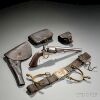MacAR
Member
I've started re-watching Hell On Wheels recently, and I've noticed something: lots of those guys are carrying cap and ball guns. I mean, like everybody; didn't notice a lot of conversions. But a lot of them also have Henry's and '66 Winchesters, and a couple of cartridge shotguns (which may not be exactly accurate). So my mind wonders (and wanders): how did the real Westerners carry spare ammo during that era? Nobody has cartridge belts that I see. I'm sure paper cartridges were in use, so did they just slip a box in their pocket? I don't notice a lot of guys carrying flasks and bullet pouches with them and don't recall reading much about how things were done then either. And while we're at it, how would they have carried their rifle cartridges? If I were going into a fight I'd want them in something other than my pocket. Just something I'd been thinking about lately.
The good thing to come out of all this psycho-analyzing is that it's made me want to start making my own paper cartridges for my '51 Navy. They'd be just the ticket for those days that I want to take it on a "woods ramble" but don't want to carry all the "extras"; just my pistol and six cartridges with caps would be more than sufficient.
Thoughts? I'm more than willing to be educated about this part of history.
Mac
The good thing to come out of all this psycho-analyzing is that it's made me want to start making my own paper cartridges for my '51 Navy. They'd be just the ticket for those days that I want to take it on a "woods ramble" but don't want to carry all the "extras"; just my pistol and six cartridges with caps would be more than sufficient.
Thoughts? I'm more than willing to be educated about this part of history.
Mac




